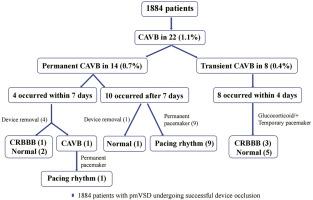Heart Rhythm ( IF 5.6 ) Pub Date : 2021-11-27 , DOI: 10.1016/j.hrthm.2021.11.027 Li Lin 1 , Jianwen Liu 1 , Xiufen Guo 1 , Hang Chen 1 , Yu Huang 1 , Huiying Zheng 1 , Wanhua Chen 1 , Lianglong Chen 1 , Liangwan Chen 1 , Zhaoyang Chen 1

|
Background
The risk factors for complete atrioventricular block (CAVB) after device closure of perimembranous ventricular septal defect (pmVSD) remain unclear.
Objective
The purpose of this study was to analyze the incidence and risk factors for CAVB after device closure for pmVSD.
Methods
We reviewed 1884 patients with pmVSD who had undergone successful device occlusion between June 2005 and January 2020. Permanent CAVB was defined as CAVB requiring implantation of a permanent pacemaker (PPM) or extraction of the occluder.
Results
In total, 14 patients (0.7%) developed permanent CAVB. Of these patients, 10 (0.5%) required PPM implantation. Four permanent CAVB occurred within 7 days after the procedure (acute), 2 between 7 and 30 days (subacute), 3 between 30 days and 1 year (late), and 5 more than 1 year (very late). None of the subacute, late, and very late CAVB recovered normal conduction with medication and eventually required device removal or PPM implantation. Four patients with acute CAVB and 1 with subacute CAVB underwent device removal, and 4 (80%) recovered normal conduction. Multivariate regression revealed that the ratio of device to defect size was the only independent risk factor for permanent CAVB (odds ratio 3.027; 95% confidence interval 1.476–6.209; P = .003).
Conclusion
The incidences of permanent CAVB after occlusion for pmVSD and PPM implantation were 0.7% and 0.5%, respectively. The ratio of device to defect size was the only independent risk factor for permanent CAVB. Device removal is an effective therapeutic modality for recovering normal conduction in acute and subacute CAVB patients.
中文翻译:

膜周室间隔缺损封堵术后房室传导阻滞的危险因素
背景
膜周室间隔缺损 (pmVSD) 封堵术后完全性房室传导阻滞 (CAVB) 的危险因素仍不清楚。
客观的
本研究的目的是分析 pmVSD 装置闭合后 CAVB 的发生率和危险因素。
方法
我们回顾了 2005 年 6 月至 2020 年 1 月期间成功进行装置封堵的 1884 名 pmVSD 患者。永久性 CAVB 定义为需要植入永久性起搏器 (PPM) 或拔除封堵器的 CAVB。
结果
总共有 14 名患者 (0.7%) 发展为永久性 CAVB。在这些患者中,10 名 (0.5%) 需要 PPM 植入。4 例永久性 CAVB 发生在术后 7 天内(急性),2 例在 7 至 30 天之间(亚急性),3 例在 30 天至 1 年之间(晚期),5 例超过 1 年(非常晚期)。亚急性、晚期和极晚期 CAVB 均未通过药物恢复正常传导,最终需要移除装置或植入 PPM。4 名急性 CAVB 患者和 1 名亚急性 CAVB 患者接受了装置移除,4 名 (80%) 恢复了正常传导。多变量回归显示,设备与缺陷大小的比率是永久性 CAVB 的唯一独立风险因素(优势比 3.027;95% 置信区间 1.476-6.209;P = .003)。
结论
pmVSD 和 PPM 植入闭塞后永久性 CAVB 的发生率分别为 0.7% 和 0.5%。设备与缺陷大小的比率是永久性 CAVB 的唯一独立风险因素。移除装置是恢复急性和亚急性 CAVB 患者正常传导的有效治疗方式。











































 京公网安备 11010802027423号
京公网安备 11010802027423号